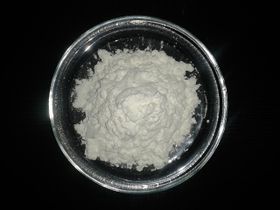Starch
 Cornstarch sample
| |
| Names | |
|---|---|
| IUPAC name
5-(5-(3,4-dihydroxy-6-(hydroxymethyl)-5-methoxyoxan-2-yl)oxy-6-((3,4-dihydroxy-6-(hydroxymethyl)-5-methoxyoxan-2-yl)oxymethyl)-3,4-dihydroxyoxan-2-yl)oxy-6-(hydroxymethyl)-2-methyloxane-3,4-diol[1]
| |
| Other names
Amylum
Clearjel Keestar Maizena | |
| Properties | |
| (C6H10O5)n (n=300-3,000) (amylose) (n=2,000-200,000) (amylopectine) | |
| Molar mass | 168.15·n |
| Appearance | White powder |
| Odor | Odorless |
| Density | 1.5 g/cm3 |
| Melting point | Decomposes |
| Boiling point | Decomposes |
| Insoluble | |
| Vapor pressure | 0 mmHg |
| Hazards | |
| Safety data sheet | ICSC: 1553 |
| Related compounds | |
| Related compounds
|
Dextrin Cellulose |
| Except where otherwise noted, data are given for materials in their standard state (at 25 °C [77 °F], 100 kPa). | |
| Infobox references | |
 |
This article is a stub. Please help Sciencemadness Wiki by expanding it, adding pictures, and improving existing text.
|
Starch or amylum is a carbohydrate, an organic compound consisting of a large number of glucose units joined by glycosidic bonds. Pure starch consists of two types of molecules: the linear and helical amylose and the branched amylopectin. Depending on the plant, starch generally contains 20 to 25% amylose and 75 to 80% amylopectin by weight.
Cornstarch is generally preferred in most reactions, though for some reactions potato starch is required.
Contents
Properties
Chemical
Starch is used in iodine clock reactions.
Mixtures with an oxidizer, like potassium nitrate will burn when ignited.
Physical
Starch is a white solid, odorless and tasteless, insoluble in cold water and other solvents. Hot water will cause starch to dissolve, a process known as starch gelatinization, which is irreversible. Starch decomposes when heated to other compounds, such as dextrin or chars at higher temperatures. Starch has an average density of 1.5 g/cm3.
When starch is mixed with water, enough until it forms a thick suspension, it forms an interesting colloidal substance called non-newtonian fluid, which has the interesting property of hardening when subjected to mechanical stress.
Availability
Starch powder is sold by most food stores and supermarkets.
Preparation
Starch can be extracted from a variety of starch containing plants such as corn, potato, wheat, etc.
Projects
- Make food
- Make dextrin
- Iodine clock reaction
- Dust explosion
- Make non-newtonian fluid
Handling
Safety
Starch has very low toxicity and is perfectly edible. However, it may stain clothing and is difficult to properly remove.
Finely dispersed particles in air can form extremely dangerous explosive mixtures, known as dust explosions.
Storage
Starch should be stored in closed containers or zip bags, away from moisture and pests.
Disposal
Starch doesn't require special disposal. Discard it as you wish.